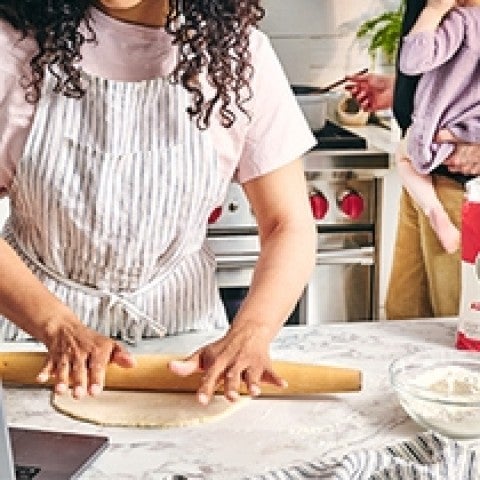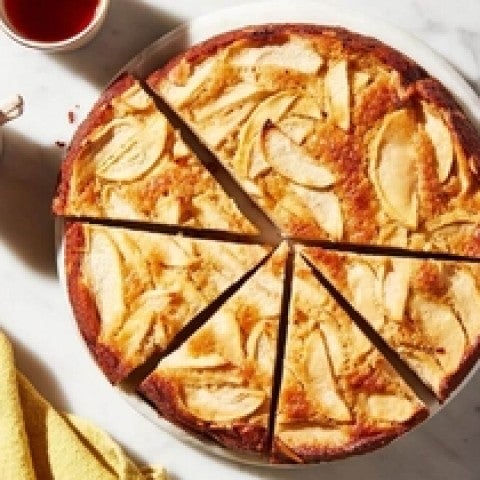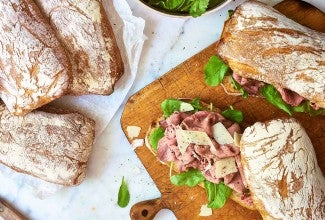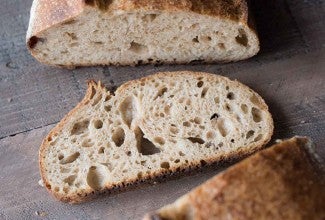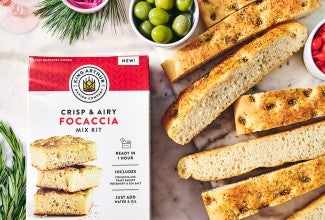-
To make the dough: In a large bowl, stir together the sourdough starter, water, and olive oil until combined.
-
Weigh your flour; or measure it by gently spooning it into a cup, then sweeping off any excess. Add the flour, salt, and sugar to the starter mixture and stir — with a spatula, bowl scraper, dough whisk, or your hands — until the mixture is thoroughly combined and homogeneous; there should be no dry patches or lumps. Cover the bowl and set it aside for 15 minutes.
-
To perform a bowl fold: Use a wet hand to grab a section of dough from one side of the bowl, then lift it up and press it into the center. Repeat this motion, grabbing a new section of dough each time, until you've made a full circle around the bowl, about 8 to 12 times. Once you’ve circled the bowl, flip the dough over in the bowl so that the smooth side is up; the first bowl fold is now complete. Cover the bowl and let the dough rest for 15 minutes.
Note: You’ll be doing this 3 more times over the next 45 minutes, each time further developing the dough’s strength.
-
Repeat the bowl fold for a second time. (Remember to use a wet hand to prevent the dough from sticking!) At this point, the dough should feel smoother and tighter. Cover the bowl and let the dough to rest for 15 minutes.
-
Repeat the bowl fold for a third time. Cover the bowl and let the dough to rest for 15 minutes.
-
Repeat the bowl fold for a fourth and final time; the dough should feel relatively strong.
-
Cover the bowl and let the dough rise at warm room temperature (70°F to 75°F) for 1 1/2 to 2 hours; see this post, Where to put bread dough to rise, for tips. At the end of the proof, the dough should have nearly doubled in size and will be very puffy; it may even have a few bubbles on the surface.
-
To prepare the pan: Once the dough has risen, spray the bottom and sides of a 9" square Fabulous Focaccia Pan with nonstick spray. (See “tips,” below for details about this pan as well as alternate pan options.) Cut a 3"-wide strip of parchment that’s about 16" long. Lay the strip across the center of the pan, leaving a few inches of overhang on two sides (to help you remove the focaccia from the pan). Press the parchment firmly into the pan, creasing it where it meets the sides to help it stay in place.
-
Spray the parchment with nonstick spray, then add 1 tablespoon (13g) of the olive oil and tilt the pan to spread the oil evenly across the bottom.
-
Use a bowl scraper or flexible spatula to gently transfer the risen dough to the pan. Using your hands as paddles (and a bowl scraper for assistance, if you need it), swiftly but gently flip the dough over so that it’s coated in oil; try to handle the dough minimally to keep it from deflating.
-
Cover the pan and let the dough rise at warm room temperature until it’s marshmallowy and jiggly; the dough should nearly fill the corners of the pan and be very close to the top edge. Depending on the ripeness of your starter and the warmth of your kitchen, this could take anywhere from 4 to 6 hours.
-
Toward the end of the rise, preheat the oven to 475°F with racks in the upper and lower thirds.
-
Once the dough has risen, lightly coat your fingers in oil and press your fingertips into the dough until they reach the bottom of the pan, creating dimples. Repeat this process, working your way from one edge to the other and spacing the dimples about 1 1/2" apart. The goal is to thoroughly dimple the dough without deflating it — aim for decisive yet gentle motions. If there are any large untouched areas of the dough, add additional dimples using one finger.
-
To top the dough: Drizzle the remaining 1 tablespoon (13g) olive oil all over the surface of the dough; it’s OK if it pools in some of the dimples. Sprinkle evenly with flaky salt (use 1 generously rounded teaspoon Cyprus Flake Salt or 1/2 teaspoon Maldon salt).
-
Bake the focaccia on the lower rack for 15 to 18 minutes, until brown in the highest spots and golden in the crevices. If necessary, move the pan to the top rack and broil for the final 1 to 2 minutes, watching carefully, to achieve the desired color.
-
Remove the focaccia from the oven. Using the parchment tabs as handles, lift the focaccia out of the pan and transfer it to a wire rack or cutting board; remove the parchment strip. Turn off the oven and slide the focaccia back into the oven, directly on the lower rack, for 5 to 7 minutes, until the sides are golden brown and crisp. Remove the focaccia from the oven once again and transfer it to a wire rack to cool completely.
-
Storage information: Focaccia is best enjoyed the day it's made. If storing leftovers, wrap the focaccia loosely in foil, keep it at room temperature, and reheat before serving.









